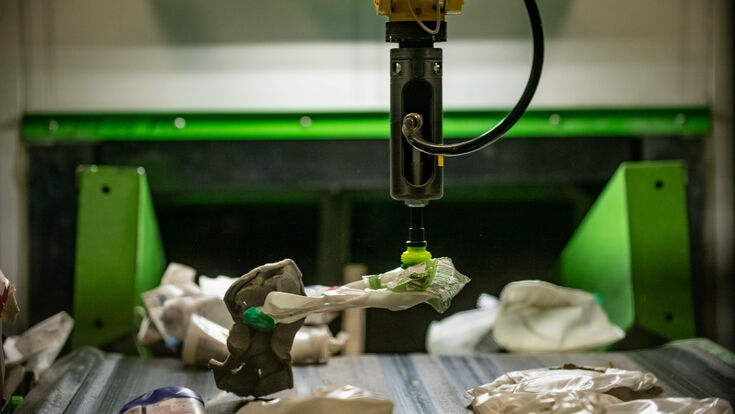Business Talk AI : "Data-driven sorting and compositional analysis is becoming vital"

What a couple of years ago sounded like science fiction is now a reality: AI-driven computer vision systems and robotic pickers. Recycleye, a growing technology company using advanced machine learning, computer vision, and robotics to commodify waste, is bringing its innovative robotic sorting technology, known as Recycleye Robotics, to IFAT 2022 after participation in Veolia Germany’s U-Start programme. Recycleye's CEO Victor Dewulf talked with WMW about the challenges of AI technology for waste sorting, the possibilities, and the digital future.
What are the challenges for developing AI waste sorting robots?
Crushed, folded, dirty, shredded – many aspects of waste in industrial settings render identification through AI-powered computer vision a challenge. But over our years of experience, we have aggregated a dataset of over 3 million waste images, meaning our robots are trained on the largest waste dataset in the world.
In an industry reliant on analog machinery and manual picking, many are resistant to transition towards intelligent technology, yet with increasingly stringent sampling and responsibility requirements, data-driven sorting and compositional analysis are becoming vital. We’re really proud to have installed our AI-driven systems with some of the leading waste management players across the UK, France, Germany, and Italy, who were ready to future-proof their facilities and invest in our European-made automating solutions.

How maintenance-intensive are the robots?
Not maintenance-intensive at all. Our grippers need to be changed once a week, which is a 2-minute job, and the vision system wiped down once a month. A benefit of AI is that it is not impacted by dust, which NIR struggles with. Whilst comparable robotic pickers often experience tubing issues, our 6-axis robot’s efficiency means we have been able to slow the picker down by 15% to achieve the same results while ensuring none of our clients have ever experienced a tubing problem.
For peace of mind, all our clients receive an annual routine maintenance check and access to FANUC’s network of maintenance engineers local to their geography.
Do the waste streams need to be pre-sorted?
It depends on the purity and efficiency that the client is aiming for each robot to achieve. Mostly, our robots automate the quality control stage of the sorting process, where a manual picker would work. At this stage, we can achieve very higher purities and efficiencies, decreasing the cost of sorting and increasing profit margins for facilities on their material bales.
Can all different sorts of waste be sorted by AI robots?
Recycleye Robotics are purpose-built for sorting household and commercial waste and can pick any dry mixed recyclables: all types of soft and hard plastics, paper, cardboard, cartons, aluminum, etc. The attractive characteristic of AI compared to NIR, is that it can detect to object granularity as well as material granularity, for example differentiating an aluminum can from an aluminum aerosol.
Ultimately, the computer vision system can be taught to identify anything that the human eye can see, so the possibilities of models we could develop in the future are endless.
What sets Recycleye’s technology apart from others?
We observed that existing robots being applied to MRFs were large and heavy, meaning clients were paying as much for installation as the robot itself, for renovations involving busting open picking cabins and fitting steel reinforcements.
As a result, we developed a robot with FANUC which is intended to be retrofitted over existing facility belts over weekend downtime, eradicating installation costs. Our robot is 75% lighter than any comparable robotic picker on the market.
Another differentiator of Recycleye Robotics is that it is a 6-axis robot with a pneumatics system, meaning it picks an item from the belt, rotates towards the correct bin, and shoots the material into it. Meanwhile, other robots must pick an item, move over to the correct bin, and drop it in – resulting in an inefficient pick path.
Our technology is backed by global partners who are the best in their business: Microsoft, Nvidia, Arrow, and FANUC, and our installation with FCC Environment was the first waste-sorting robot of its kind in England.
Where do you see the biggest market growth?
What’s exciting about this technology is that we envision it creating whole new material resale markets: with pure food-grade PET bales selling for up to 8x more than mixed plastic bales, sorting to food-grade granularities in all material types will equip MRFs with previously impossible revenue streams. With nations across the world transitioning toward EPR schemes, this is an industry trend that is already becoming imminently important.


